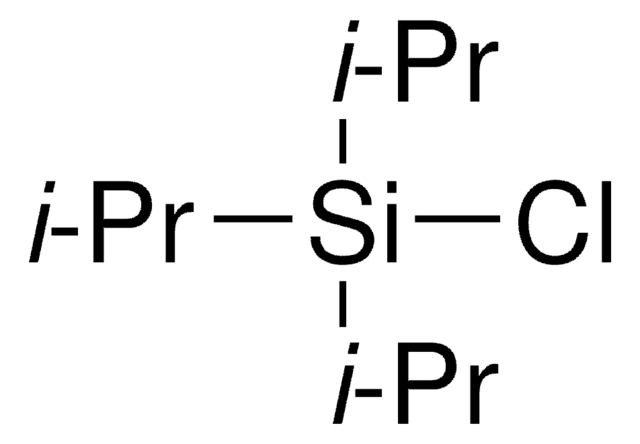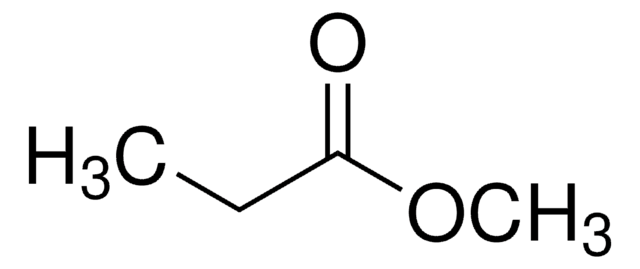259942
Methyl hexanoate
99%
Synonym(s):
Caproic acid methyl ester, Methyl caproate
Sign Into View Organizational & Contract Pricing
All Photos(3)
About This Item
Linear Formula:
CH3(CH2)4COOCH3
CAS Number:
Molecular Weight:
130.18
Beilstein:
1744683
EC Number:
MDL number:
UNSPSC Code:
12352100
PubChem Substance ID:
NACRES:
NA.22
Recommended Products
Quality Level
Assay
99%
form
liquid
refractive index
n20/D 1.405 (lit.)
bp
151 °C (lit.)
mp
−71 °C (lit.)
solubility
chloroform: soluble 100 mg/mL, clear
density
0.885 g/mL at 25 °C (lit.)
SMILES string
CCCCCC(=O)OC
InChI
1S/C7H14O2/c1-3-4-5-6-7(8)9-2/h3-6H2,1-2H3
InChI key
NUKZAGXMHTUAFE-UHFFFAOYSA-N
Looking for similar products? Visit Product Comparison Guide
General description
Hydrodeoxygenation of methyl hexanoate on commercial NiMo/γ-Al2O3 and CoMo/γ-Al2O3 hydro treatment catalysts in either oxide or sulphided form has been investigated. The oxidation of methyl hexanoate in a jet-stirred reactor has been studied.
Application
- Effect of fat nature and aroma compound hydrophobicity on flavor release from complex food emulsions.: This study examines how the type of fat and the hydrophobic nature of aroma compounds, including methyl hexanoate, affect flavor release in food emulsions. The findings highlight the importance of molecular interactions in designing food products with optimized flavor profiles. (Relkin et al., 2004).
Signal Word
Warning
Hazard Statements
Precautionary Statements
Hazard Classifications
Flam. Liq. 3
Storage Class Code
3 - Flammable liquids
WGK
WGK 3
Flash Point(F)
99.5 °F - closed cup
Flash Point(C)
37.5 °C - closed cup
Personal Protective Equipment
dust mask type N95 (US), Eyeshields, Gloves
Choose from one of the most recent versions:
Already Own This Product?
Find documentation for the products that you have recently purchased in the Document Library.
Customers Also Viewed
Rebecca M Turner et al.
The Journal of biological chemistry, 289(46), 31837-31845 (2014-10-02)
Insect odorant receptors are heteromeric odorant-gated cation channels comprising a conventional odorant-sensitive tuning receptor (ORx) and a highly conserved co-receptor known as Orco. Orco is found only in insects, and very little is known about its structure and the mechanism
Hydrodeoxygenation of methyl esters on sulphided NiMo/?-Al2O3 and CoMo/?-Al2O3 catalysts.
Senol OI, et al.
Catalysis Today, 100(3), 331-335 (2005)
Experimental and kinetic modeling study of the oxidation of methyl hexanoate.
Dayma G al.
Energy and Fuels, 22(3), 1469-1479 (2008)
Suhyoung Bahk et al.
BMC biology, 14(1), 83-83 (2016-10-01)
Like most animals, insects rely on their olfactory systems for finding food and mates and in avoiding noxious chemicals and predators. Most insect olfactory neurons express an odorant-specific odorant receptor (OR) along with Orco, the olfactory co-receptor. Orco binds ORs
David M Obenland et al.
Journal of agricultural and food chemistry, 51(11), 3367-3371 (2003-05-15)
Volatile emissions of navel orange (Citrus sinensis L. Osbeck cv. Washington) fruit were evaluated as a means for predicting and gauging freeze damage. The fruits were subjected to -5 or -7 degrees C treatments in a laboratory freezer for various
Our team of scientists has experience in all areas of research including Life Science, Material Science, Chemical Synthesis, Chromatography, Analytical and many others.
Contact Technical Service












